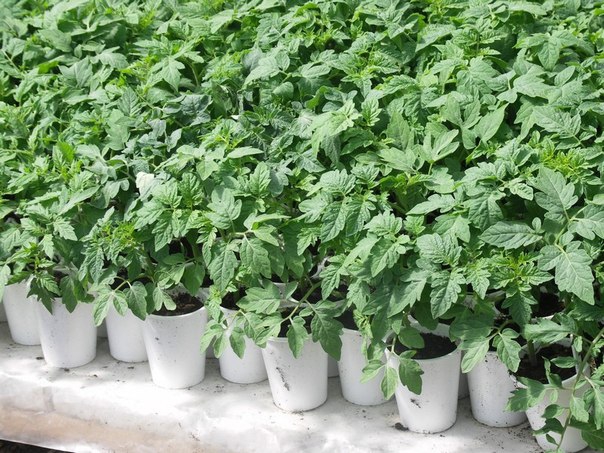Everyone who grows tomatoes on his plot, at least once in his life has met with yellowed or drooping leaves. This significantly affects the yield of plants, so the problem must be eliminated immediately. Next, we describe the causes of yellow spots on the seedlings of tomatoes and methods of dealing with these ailments.
Table of contents
Causes of yellow spots on tomato seedlings
Yellow leaves of tomatoes are a sign that the plant is experiencing stress.
They occur in tomatoes due to:
- improper care;
- diseases.
There are several types of yellowness:
- several lower yellowed leaves. This happens when transplanting tomatoes. Lower leaflets can curl and dry.
- yellow leaves with a blue tint. The reason is hypothermia.
- rapid yellowing of the leaves at the bottom of the bush. These are symptoms of a damaged root system.
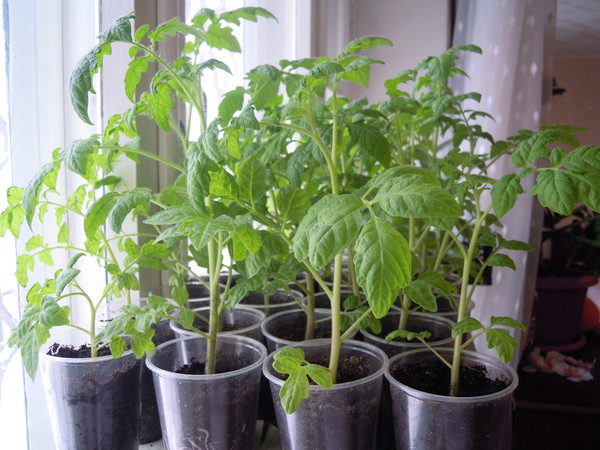
Bad care
Incorrect care can be attributed to errors in:
- watering;
- loosening;
- lighting;
- top dressing.
Failure to watering can result in twisted, yellow, drooping leaves. Plants wither and even die. Why does this happen? This is due to an excess or lack of water. Tomatoes need abundant, but rare watering. In the open ground no more than 2 times a week. Volume - 5 liters under one bush. Best before lunch.
Lack of minerals
Yellow leaves may occur due to lack of minerals:
- with a lack of nitrogen, all plants are stained;
- copper - no spots, but the whole bush loses its color;
- Sulfur - leaves turn yellow, become hard;
- magnesium - small spots;
- manganese - fast yellowing, rot;
- phosphorus - yellowed tip.
Loosening is done to enrich the roots with oxygen. Too frequent, deep loosening can cause root damage. Depth - no more than 10 cm.
Wrong lighting
Wrong lighting - Another cause of yellowed leaves. When sunburn occurs white spots. On hot, sunny days, bushes, seedlings should be pritenyat.
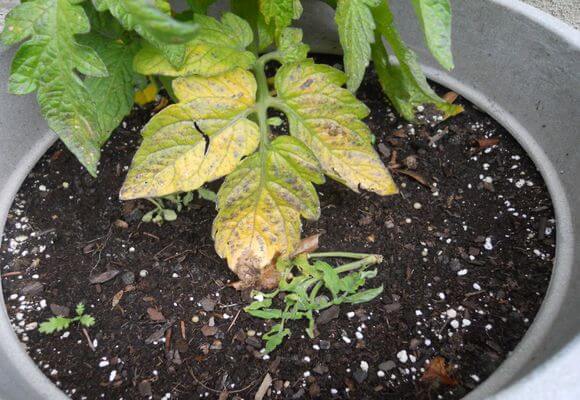
Pest damage
Diseases affecting tomatoes can be:
- fungal;
- kladoporiosis (yellow-brown, brown spots);
- Fusarium (yellow-green, twisted, sluggish leaves);
- phytophthora (brown spots);
- gray rot (brown spots, gray scurf);
- bacterial;
- bacterial cancer (white spots with black center);
- viral;
- tobacco mozayka virus (mosaic color, with alternating dark and light green colors);
- virus curliness (yellow on the edges of the sheet).
In greenhouses, greenhouses problems with tomatoes more. Here, high humidity, high air temperature - excellent conditions for the development of disease. Therefore, watering - no more than once a week.
Why leaves of tomatoes wither and die
Causes of drooping leaves:
- non-compliance with the norms of agricultural engineering;
- diseases.
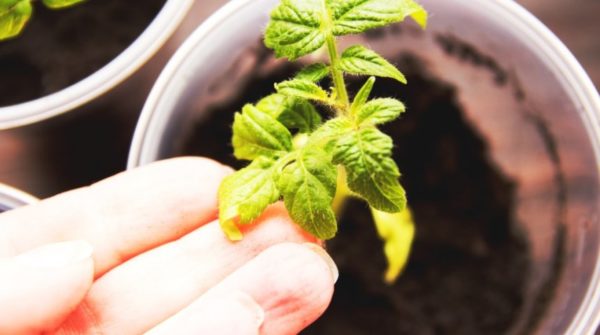
Improper care of plants is:
- thick landing;
- inappropriate plot;
- insufficient, excessive amount of water;
- improperly selected soil;
- lack of excess sunlight;
- overheating, overcooling;
- in humid air;
- drafts;
- improper feeding.
With a dense planting of seedlings, they obscure each other. There is competition for sunlight. Bushes drawn out. The roots lack space. There is a struggle for water, nutrients. The result is a flaccid bush. Black leg disease may occur.
Fusarium fungal disease causes wilting of tomato leaves. In this case, the roots become red in color, the leaves turn yellow. Diseases can be defeated only at an early stage of development. If the bush can not be cured, it must be removed, burned. Land to handle.
Good lighting is required. Light is needed for photosynthesis. When early planting seedlings in the greenhouse, you can use additional lighting - fluorescent lamps. But do not cover the plant during the day. Some processes in the plant take place only in the dark.
If the plants are in the greenhouse, the greenhouse the daytime air temperature should be no higher than 28aboutC, at night - 18aboutC. Optimum - 24 - 26aboutC. At a temperature of 38 - 40aboutC leaves begin to fall. Requires regular airing.
Tomatoes love warm. Cold can cause drooping leaves. At temperatures below 15about C they do not absorb phosphorus, at 10about C is nitrogen.Top dressing bushes must be balanced.
How to cure plants in a greenhouse
If the tomatoes are drooping, the leaves turn yellow, the first step is to establish the cause. Sometimes changing growing conditions help get rid of problems. It is required to adjust the level of watering, feeding, light, temperature.
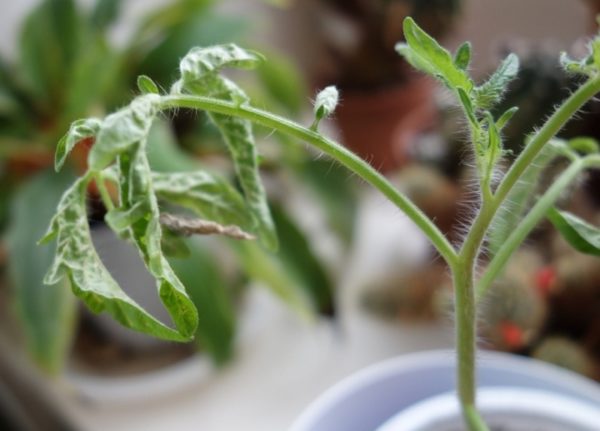
Yellowed leaves must be removed, otherwise the plant may begin to fall and die.If there is a shortage of some microelement, you need to feed it with appropriate fertilizer. For example, nitrogen starvation is eliminated by spraying with urea.
For sunburns, reduce the amount of sunlight. In the case of seedlings, they can be tinted with the help of paper, closing the glass of the window to it. In the case of improperly selected soil, over-moistening the soil, the tomatoes should be dug out and transplanted to a suitable place, otherwise the seedlings will begin to rot and disappear.
If the cause could not be established, it is possible to treat the tomatoes with copper sulfate (70 - 80 grams per 10 liters of water).
Tomatoes affected by diseases, pests must be treated with the appropriate drug. The bushes to uproot. Burn it. Land, work equipment, gardener's clothes to process.
Preventing wilting and yellowing tomatoes on the windowsill
For the prevention of the appearance of problems with seedlings, it is necessary to know the conditions for growing these nightshade. Only the right actions will help gardeners to deal with the problems that have arisen.
Required conditions for growing tomatoes:
- slightly acid, neutral soil;
- light day at least 12 hours;
- moderate amount of fertilizer;
- warm, dry air;
- regular airing;
- moderate watering.
What conditions are contraindicated for tomatoes:
- cold;
- high soil moisture, air;
- heavy, sour soil;
- dense planting bushes;
- high air temperature;
- excess amount of fertilizer.
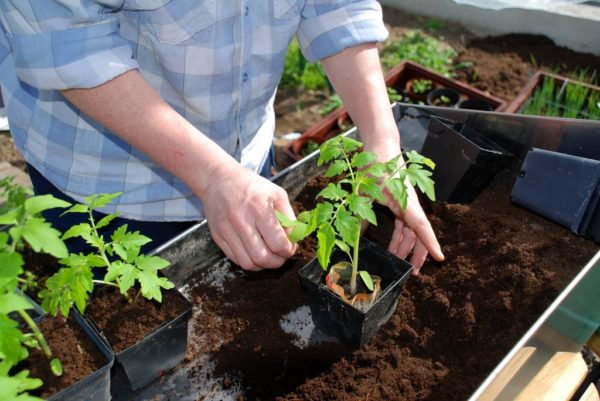
For preventive purposes, you should regularly loosen the ground under bushes. This contributes to the enrichment of the roots with oxygen. Water does not stagnate under the tomatoes.
When planting is recommended to acquire resistant to diseases, pests varieties of tomatoes. Seeds, soil, planting containers, working equipment at the beginning of the season must be processed.
The distance between seedlings is at least 40 cm. Depending on the variety. During the installation of a greenhouse, greenhouses should provide a ventilation system. It is required to make a crop rotation every year. Tomatoes in the same place can be planted only 3 - 4 years after the last planting.
In early spring, late autumn, it is necessary to process the greenhouse, greenhouse with sulfur blocks.This is done to destroy parasites, pests and diseases (rust, spotting).
The causes of wilting, yellow dots on tomatoes can be many. Starting from normal biological aging, transplantation and to serious illness. With proper care, compliance with preventive measures, all these problems can be avoided. Compliance with all norms of agricultural technology will reward the gardener with a bountiful harvest and will help save plantings.
